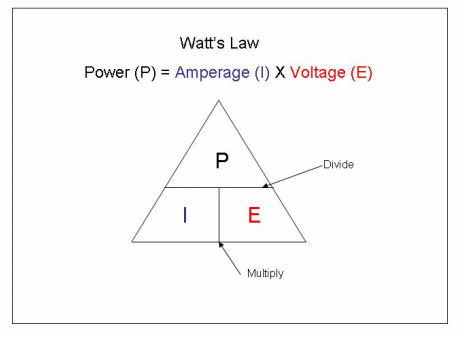
Title: Watt’s Law
Description: Wattage is another important term used to help the street rodder analyze electrical circuits and systems. Wattage is calculated by using Watt’s Law. Wattage is a measure of the power (P) used in the circuit and is also a measure of the total electrical work being done per unit of time. When voltage (E) is multiplied by amperage (I), the result is wattage or power (P). Wattage, which is a measure of electrical power, may also be referred to as kilowatts (kW). One thousand watts equals 1 kilowatt. The drawing on the left illustrates the relationship between voltage, amperage, and wattage. If the amperage and wattage are known, cover the voltage to see the formula. If the voltage and wattage are known, amperage can also be calculated by dividing the voltage (E) into the wattage or power (P).
Relationship to Street Rods: Wattage (or watts) is used to describe batteries and battery performance. For example, batteries that are used in street rods are often rated by using watt-hours. A watt-hour is the amount of power or watts that can be produced from a battery for a period of 1 hour. It is typically used as an indicator of the amount of power that a particular battery is capable of producing. Also, batteries are rated by amperage during cold cranking, such as 350 cold cranking amps. If 350 cold cranking amps are being used with a 12 volt battery, under these conditions, 4200 (12 x 350) watts would be produced. Wattage is also used to rate light bulbs such as a 5 watt or 10 watt light bulb.
It should be noted that if the voltage in street rod electrical system is using a 12 volt battery, as the wattage specification increases on a component or part, the amperage capability will also increase. This becomes important because as amperage increases, the size of wiring selected for a specific circuit may also have to be increase to handle the increased amperage.
Back to Electrical Principles